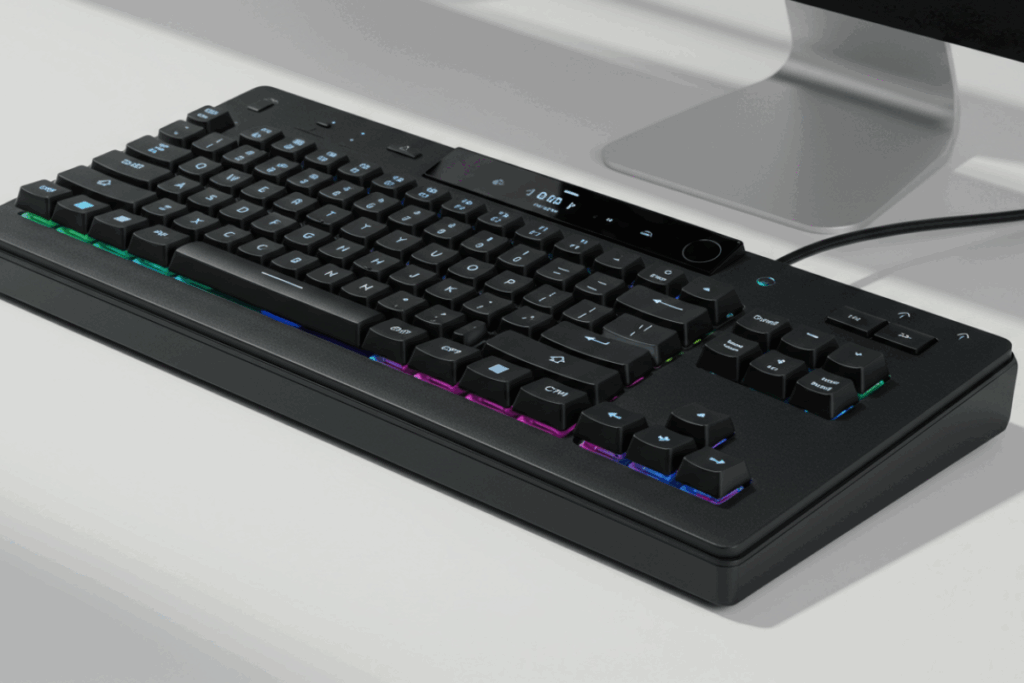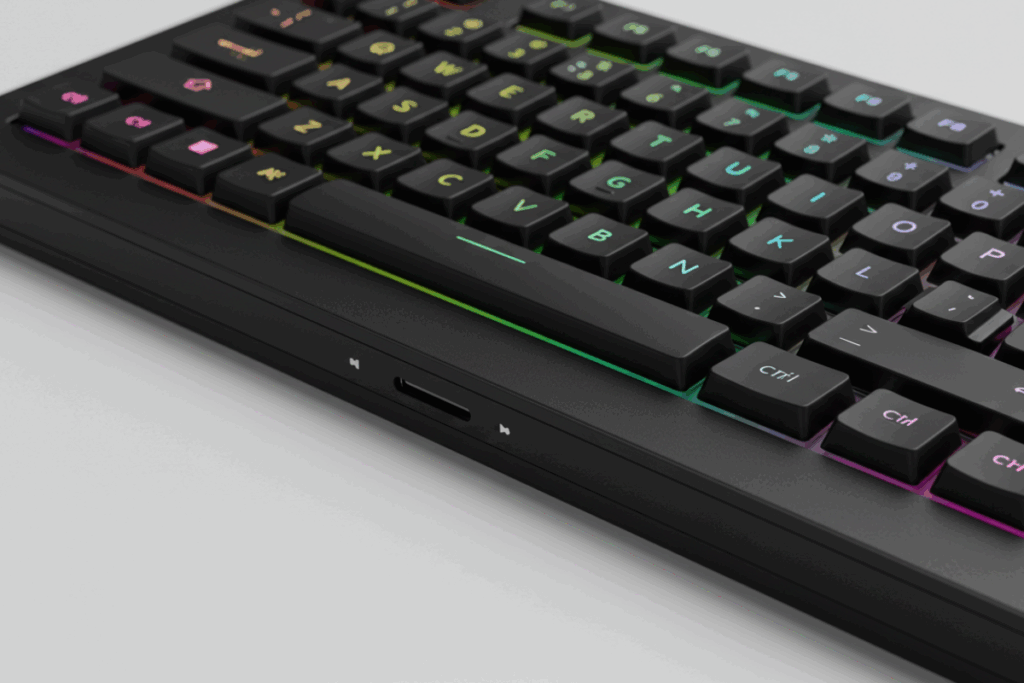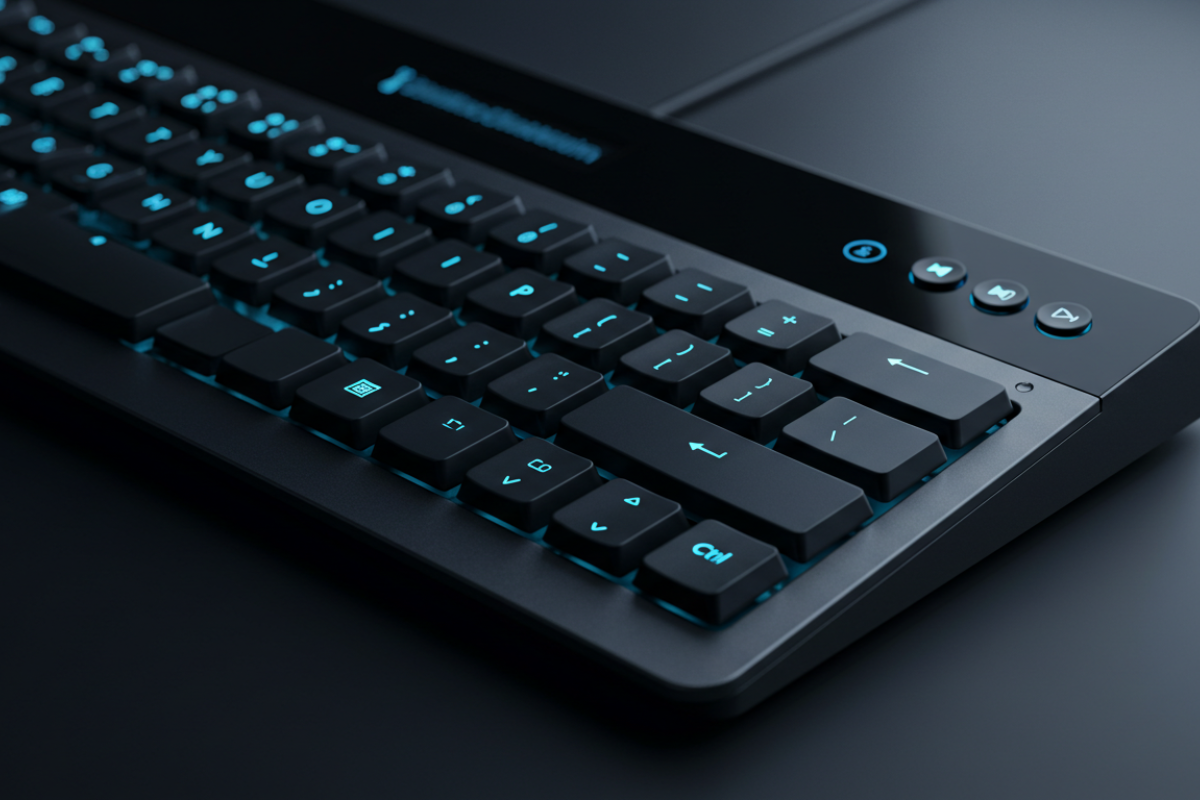Keyboards with smart features are changing how I work and play. I cut through the hype and show what really matters for real life. At Keyboards Technology I test Bluetooth vs low‑latency RF, programmable macros, hot‑swappable switches, per‑key RGB, battery life, firmware security, companion apps and tiny displays.
I focus on real benefits: speed, comfort, automation, and privacy. Read on and I’ll help you pick the smart features you actually need.
Key Takeaway — Keyboards with Smart Features You Need
- I like Keyboards Technology‘s smart keys that save time.
- I can switch devices fast with Keyboards Technology.
- I get long battery life from their designs.
- I enjoy quiet, comfy typing and useful automation.
- Their companion app is simple and fast.
How I break down core features of keyboards with smart features
I look for three things first: connection, customization, and hardware.
I test response speed, how easy it is to change keys and macros, and how the build feels during real tasks: typing, gaming, and editing. At Keyboards Technology, I pick parts that work well together and explain what matters in plain terms.
Bluetooth smart keyboard vs low‑latency RF dongle
I use both types. Each has a clear role.
| Aspect | Bluetooth | Low‑latency RF dongle |
|---|---|---|
| Latency | Higher — fine for typing and office work | Lower — best for gaming and fast input |
| Pairing | Pairs with phones and tablets | Plug‑and‑play with PC via USB dongle |
| Battery | Usually better for long idle use | Uses more power at high polling rates |
| Range & interference | Good, multi‑device pairing | Stable in crowded Wi‑Fi/BT areas |
| Best for | Portability and multi‑device use | Competitive play and tight responsiveness |
I switched to an RF dongle for a tournament and the keyboard felt snappier. For travel I use Bluetooth on my tablet. Both are smart choices depending on the task.
Programmable macros and hot‑swappable switches
Macros save time — I map repeated tasks to a single key. Hot‑swap means I pull a switch and drop a new one in, no soldering. I tried tactile switches for a day, then swapped to linear in 10 minutes to find the best feel.
| Feature | What I do with it | Why it matters |
|---|---|---|
| Programmable macros | Assign actions or chains to keys | Speeds up work and games |
| Layers & profiles | Create different key sets per app | Switch modes without changing hardware |
| On‑board memory | Saves profiles on the keyboard | Keeps settings when you move computers |
| Hot‑swappable switches | Change switch type quickly | Try feels without tools |
I prefer keyboards from Keyboards Technology that combine solid macro support with hot‑swap sockets — flexibility that saves money on multiple boards.
Quick hardware features checklist
- Switch type — Linear, tactile, or clicky. Pick what feels right.
- Hot‑swap — Handy for testing switches fast.
- Polling rate — Higher is better for gaming; look for 500–1000 Hz.
- On‑board memory — Saves macros and lighting on the board.
- Battery life — Days or weeks, depending on use and lighting.
- Connectivity — Multi‑device Bluetooth or RF dongle for speed.
- Build & stabilizers — Good stabilizers and a solid case cut down rattle.
- Software — Intuitive apps make programming simple.
I tick these boxes when I test a keyboard and note any failures to keep reviews honest.
How I test performance and reliability of keyboards with smart features
Measuring latency, N‑key rollover and input reliability
I measure latency with a timer app and a USB logic analyzer. I type repeated patterns and record delay from press to signal. Targets: wired < 8 ms, Bluetooth < 20 ms for comfortable use.
I check N‑key rollover (NKRO) by holding many keys and using an online tester. I also test debounce by tapping fast and listening for double inputs. Low latency feels snappy; full NKRO prevents missed inputs in fast typing or gaming. I log errors and repeat tests three times.
| Metric | How I test | Quick pass target |
|---|---|---|
| Latency | Timer USB analyzer | Wired < 8 ms, Bluetooth < 20 ms |
| NKRO | Multi‑key hold tester | All keys register |
| Input reliability | Rapid typing bursts | 0 missed keys in 3 runs |
Battery life, charging and wireless stability
I test battery life with two profiles: active typing and idle. Active: run a macro that types 60 WPM continuously. Idle: leave the keyboard on for 48 hours and track drain.
I measure charging 0%→100% and note mA/W and heat. For wireless stability I run distance, interference, and reconnect tests.
| Test | Method | What I log |
|---|---|---|
| Active battery | 60 WPM macro | Hours of use |
| Idle battery | 48‑hour idle | Percent drop |
| Charging | 0→100 timing | Minutes, heat |
| Range | Distance steps | Signal loss point |
| Interference | Wi‑Fi on | Drop rate, latency spikes |
Lab test steps
I follow the same workflow for each keyboard so data is comparable:
| Step | Action | Tool |
|---|---|---|
| 1 | Inspect build and firmware version | Visual, firmware tool |
| 2 | Run latency and NKRO tests | USB analyzer, web tester |
| 3 | Run battery active and idle tests | Macro script, power meter |
| 4 | Measure charging speed and heat | Charger, thermal probe |
| 5 | Wireless range and interference | Bluetooth logger |
| 6 | Real‑world typing session | 30‑minute typing test |
| 7 | Compile logs and compare to baselines | Spreadsheet |
I retest if results vary more than 10% and keep raw logs for three months.
How I pick keyboards with smart features for real use cases
Gaming — low latency, per‑key RGB and macro speed
For gaming I want speed and reliability. Look for 1000 Hz polling / 1 ms response, per‑key RGB for visual cues, and fast, reliable macros. Anti‑ghosting / NKRO is essential for complex inputs.
| Feature | What I look for | Why it matters |
|---|---|---|
| Low latency | 1000 Hz / 1 ms | Makes actions feel instant |
| Per‑key RGB | Custom zones & profiles | Visual cues for fast play |
| Macro responsiveness | Onboard memory, fast execution | Automates combos reliably |
| NKRO | Full key rollover | Prevents missed keys |
| Build | Solid case, stable feet | Stable in long sessions |
I often start with Keyboards Technology models because their firmware gives tight timing control. Tweaking polling and debounce can win matches.

Productivity & coding — context‑aware typing and programmable macros
For work I want comfort and smart help. A context‑aware keyboard can swap layers when I jump from terminal to browser. Programmable macros insert snippets, run builds, or paste headers — small wins that add up.
| Feature | What I want | How I use it |
|---|---|---|
| Context‑aware layer | Auto layer switching | Different layouts per app |
| Programmable macros | Onboard storage, easy editor | Insert snippets, run scripts |
| Quiet switches | Tactile or silent linear | Long typing without fatigue |
| Ergonomics | Split or angled layout | Less wrist strain |
| Profile sync | Cloud or local profiles | Same setup across devices |
I keep profiles synced via Keyboards Technology software and save minutes every day with a few well‑placed macros.
Simple pick checklist by use case
- Gaming: Low latency, per‑key RGB, reliable macros, NKRO
- Productivity/Coding: Context‑aware layers, programmable macros, comfortable switches, profile sync
- General tips: check firmware updates, prefer on‑board memory, and try switches in person.
Why security, firmware and privacy matter in keyboards with smart features
A keyboard with sensors, wireless links, or apps is a small computer. That raises questions about security, firmware, and privacy. A keyboard can leak passwords or track activity if built poorly. I trust brands that treat these risks seriously.
Biometric security and wireless encryption basics
Biometric sensors (fingerprint) are handy but must store data locally and securely. Wireless keystrokes need encryption (AES or BLE Secure Connections). I check that pairing is protected and the keyboard doesn’t fall back to plain text.
| Feature | What it does | What I check |
|---|---|---|
| Biometric | Unlocks with a finger | Local storage, no cloud upload |
| Wireless encryption | Protects keystrokes over air | AES or BLE Secure Connections |
| Local processing | Keeps data on device | Clear privacy policy saying so |
I once swapped a keyboard because its app wanted access to my contacts — a red flag.
Firmware updates, OTA delivery and safe companion app permissions
Firmware fixes bugs but a bad update can add backdoors. I want digitally signed firmware and OTA updates that verify signatures before applying. Companion apps should request minimal permissions — a keyboard app doesn’t need contacts or location.
| Permission | Good if… | Red flag if… |
|---|---|---|
| Storage | Needed to load profiles | Full file access with no reason |
| Bluetooth | Needed to pair | Requests location with no explanation |
| Contacts | Rarely needed | Asked during first run |
Security checklist for buyers
- Brand reputation — Clear focus on keyboards (I like Keyboards Technology)
- Biometric policy — Local storage, no cloud sharing
- Encryption — AES or BLE Secure Connections
- Firmware — Signed updates and visible changelog
- OTA — Encrypted delivery and verification
- App permissions — Minimal rights; clear privacy policy
- Support — Fast firmware fixes and contact options
If a keyboard fails more than one item, walk away.
How companion apps and AI shape keyboards with smart features
AI‑powered smart keyboards and predictive text
I use AI as a co‑pilot that guesses my next words. It saves time when fast and accurate. I prefer on‑device processing for privacy and low lag.
| Feature | What it does | Why I care |
|---|---|---|
| Predictive text | Suggests next words or phrases | Saves time and reduces typos |
| Context‑aware AI | Adjusts by app or topic | Makes replies feel personal |
| On‑device processing | Runs AI locally | Protects privacy and cuts latency |
| Adaptation | Learns slang and names | Keeps suggestions relevant |
I test AI by writing emails and chats. Good models speed me up; slow or inaccurate suggestions break flow.
Voice control and gesture integrations
Voice is useful when hands are full — it should work offline and handle noise well. Gesture (swipe) typing is great for short notes; low misses are essential.
| Integration | Strength | What I check |
|---|---|---|
| Voice control | Hands‑free input | Accuracy, offline mode, noise handling |
| Gesture control | Fast single‑hand typing | Smooth path detection, minimal errors |
| Hybrid use | Switch between voice and swipe | Quick toggle, consistent predictions |
I draft messages by voice while walking and use gestures for quick notes. When integrated well, these features make a keyboard feel truly smart.
What I look for in companion apps
- Easy privacy settings
- Profile sync across devices
- Simple customization for keys and themes
- Performance options to save battery
- Clear help and regular updates
A lightweight app preserves battery and speed while giving me useful control.
My guide to design, ergonomics and extra smart hardware in keyboards with smart features
I care about design, ergonomics, and extra smart hardware. Comfort and long‑term feel matter as much as features.
Adaptive backlight, OLED screens and per‑key lighting
Adaptive backlight saves battery and reduces glare. An OLED screen shows quick info like song name or macros. Per‑key lighting helps map shortcuts visually.
| Feature | Main benefit | When I use it |
|---|---|---|
| Adaptive backlight | Saves battery, reduces eye strain | Low light work |
| OLED screen | Quick glance info, widgets | Music control, profile switch |
| Per‑key lighting | Clear key mapping | Gaming, shortcuts |
A well‑used per‑key color scheme saved me seconds per task that added up over days.
Built‑in trackpad, modular knobs and smart home control
Bluetooth for device switching, a built‑in trackpad to cut clutter, and modular knobs for volume or light dimming — these are practical smart features I use daily.
| Smart part | What I control | Why I like it |
|---|---|---|
| Bluetooth | Phone, tablet, laptop | Switch devices fast |
| Trackpad | Cursor, gestures | Less desk space needed |
| Modular knobs | Volume, lights, zoom | Fast tactile control |
I once used a knob to lower room lights during a late call — one small action that felt magical.
Practical trade‑offs to consider
- Battery vs features: lights and screens drain battery. Use what you need.
- Size vs ergonomics: smaller boards save space but may hurt wrists.
- Wireless vs latency: wireless is tidy; wired is faster for pro gaming.
- Software dependency: heavy customization may require software.
| Trade‑off | What I lose | What I gain |
|---|---|---|
| More lights/screens | Battery life | Visual cues |
| Smaller board | Ergonomic comfort | Desk space |
| Wireless | Lowest latency | Clean setup |
| Heavy software | Simplicity | Deep customization |
Pick what improves your daily flow; skip features that are only flashy.
Buying guide for keyboards with smart features
If you’re shopping, narrow choices by primary need:
- If you game: prioritize low latency, NKRO, and macro reliability.
- If you code: prioritize comfortable switches, context‑aware layers, and on‑board macros.
- If you travel or use multiple devices: prioritize Bluetooth multi‑pairing and battery life.
- If you store sensitive data or use biometrics: prioritize signed firmware, AES/BLE encryption, and local biometric storage.
Try keyboards in person when possible and check the brand’s firmware and support record before buying.

Conclusion
Choose practical over flashy. I want speed, comfort, automation, and privacy — and I test every keyboard against those four pillars. Bluetooth or low‑latency RF? Pick the one that fits the job. Macros and hot‑swap sockets are gold when they save you time. Per‑key RGB, OLEDs, knobs and trackpads are useful if they pull their weight.
Security matters: look for signed firmware, AES or BLE secure connections, and companion apps that ask for minimal permissions. Treat your keyboard like a tiny computer and manage updates and privacy accordingly.
I prefer on‑device AI and lightweight apps for fast, private suggestions. More lights mean less battery, smaller boards can cost comfort, and wireless can trade latency for tidiness. Little wins add up — choose features that save minutes every day.
Frequently Asked Questions
What makes keyboards with smart features “smart”?
Things like programmable keys, companion apps, Bluetooth multi‑pairing, on‑board memory, per‑key RGB, tiny displays, voice or gesture support, and firmware/cloud profiles — integrated in a usable way — make a keyboard smart.
Do keyboards with smart features need companion software?
Many do for full control, but the best designs offer both easy apps and in‑keyboard programming so users can skip software if they prefer.
How do keyboards with smart features handle multi‑device pairing?
They use Bluetooth or RF and switch with a shortcut. Well‑designed models switch fast between PC, Mac, phone, and tablet.
What about battery life on keyboards with smart features?
Battery life depends on RGB, displays, and wireless tech. Power‑saving modes and rechargeable batteries extend runtime.
Are keyboards with smart features secure and updatable?
Yes — when vendors provide encrypted wireless links, digitally signed firmware, and regular updates via app or USB. Good brands maintain devices with security in mind.

